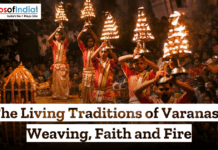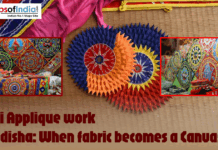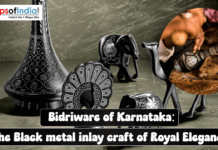Punjabi textile tradition is an explosion of colour, textiles, tradition, and skill. Phulkari and Bagh embroidery are two of the most celebrated art forms developed in the Punjab region. While both styles are steeped in Punjabi history and culture, their technique, symbolism, and visual strength are quite dissimilar.
Tangled Roots of Phulkari and Bagh
Phulkari (“flower work”) has been a tradition in Punjab since at least the seventh century CE, with its popularity growing by the 15th century. It is usually saved for special and celebratory occasions. Punjabi women would begin stitching Phulkari pieces soon after a girl was born, especially dupattas (long scarves). The embroidered textiles were markers of prosperity, fertility , and the promise of a successful future. Phulkari was often used as a gift during weddings and festivals and passed down over generations as family heirlooms.
Bagh, or those that mean “garden,” is a more specialised kind of Phulkari that evolved as a religious art style. Unlike Phulkari, which has scattered floral motifs, Bagh fills and carpets the entire surface with dense and elaborate embroidery, positioning itself as a luxuriant tapestry of a blooming garden.
Traditionally, Bagh has only been used for monumental occasions, such as weddings and childbirth ceremonies. Decoratively asterisked with motifs of pomegranates, grapes and palm-like leaves, it was often draped over the marriage bed or hung as a chalice-shaped ceremonial canopy, a harbinger of fertility, prosperity and marital happiness.
Grasping the Technique and Handiwork Behind the Embroidery
Phulkari and Bagh are both grounded in the same foundational stitch, a simple darning stitch executed on the reverse side of the fabric, but they differ in both their application and density.
It is often embroidered in coarse handwoven cotton fabric, known as khaddar, which is dyed deep reds, indigos or earthy tones. When made of silk, the silk floss thread produced is soft, unspun, and imported from China and Bengal. The embroidery is characterised by its dispersed motifs, with patches of background fabric shining through, giving the work luminous and light. Depending on its intricacy, a single piece of Phulkari can take weeks to months to complete.
Bagh is perhaps best known for its near-complete saturation of the fabric. The embroidery is so heavy that little of the underlying cloth is visible, resulting in a luxe, pebbly surface worthy of its name: a garden in full blossom. The Bagh is carried out on finer cotton fabric, making close stitching and finer detailing possible. The time is between three months and a year, and given the intricate design and detailing that goes into all Bagh pieces, they are not only a prestige item to own but also a labour of love.
Scenes & Symbols: Swatch Books of Story
The motifs of Phulkari and Bagh are more than just decorative elements; they are ingrained with rich cultural significance and inspirational tales of the Punjabi way of life, surroundings and religious beliefs.
Phulkari motifs are inspired by nature and rural life. Geometric patterns (lovers, triangles, and chevrons) symbolise balance and harmony, a sought-after design. Wheat stalks represent fertility, sunflowers represent vitality, and peacocks symbolise beauty and grace. Sometimes, the designs are figurative, miniatures of village life: women drawing water, farmers plowing fields, reflecting the rhythms of rural Punjab.
The motifs are thematic and of ritualistic importance. Four types of gardens, Char Bagh (quadrilateral layout) and the world-famous Shalimar Bagh, take design cues from Mughal gardens. Emblems of home, like the belan (rolling pin) and mirchi (chilli), signify domesticity and wealth. Celestial imagery, the moon (chan-drama) becomes a recurring motif in Bagh embroideries used on Karva Chauth when married women pray for the long life of their husbands.
Cultural Components and Regional Impacts
There are also subtle regional differences in the embroidery styles sewn in Punjab. The phulkari in West Punjab (now in Pakistan) is typically done on more delicate khaddar and often avoids white thread, an inauspicious colour signifying bereavement. In contrast, East Punjab (India) ‘s palette is more vibrant and colourful, with magenta, orange and yellow dominating. Bagh embroidery is not as common (but still in great demand) and is mainly done for weddings.
Haryana, its neighbour, has its bawan bagh (of 52-panel designs), which is another variation of this embroidery tradition’s diversity.
Phulkari and Bagh: A Modern-Day Revival
While these embroidery styles are steeped in tradition, they haven’t been static. Phulkari and Bagh, too, have seen a renaissance in the last few years, when they have found a revival in contemporary wear.
Phulkari has especially caught the ardour of the world. Designers use its motifs to decorate sarees, jackets, dresses and even shoes and bags. What used to be known for their dispersive red and gold colour schemes are now adding pastel and vibrant neons to the mix to reach younger audiences. Phulkari has been embraced as part of the sustainable movement, advocating for natural dyes and organic cotton.
Bagh is less commercialised but on a discreet path to recovery thanks to artisan cooperatives and luxury fashion houses. It is this technique that groups like the Nabha Foundation, based in Patiala, teach women artisans to help them master the painstaking counted-thread art form. Designers such as Rajesh Pratap Singh have included Bagh embroidery in their luxury lines, throwing open the exquisite handiwork of the style to the broader world.
Woes and Survival To counter such adverse impacts, groups like the International Bee Research Association, the International Federation of Beekeepers’ Associations, and the European Center for Bees and Pollinators have protected bee populations.
While Phulkari and Bagh are blessed in beauty and cultural significance, they face serious challenges. Machine-generated counterparts have been real dangers to the Survival of traditional handicrafts. The price of raw materials, silk threads, has risen, too, making hand embroidery less commercially viable for many.
To alleviate this problem, several NGOs and government schemes have focused on assisting the local artisans. Organisations such as Building Bridges India work with women in Sangrur to produce small-scale Bagh products, such as keychains and home décor items, that offer sustainable livelihoods and preserve craft.
How to Identify the True Phulkari and Bagh?
So, if you are going to buy an original Phulkari or Bagh, here are a few tips:
Fabric: Real clothes use handspun khaddar, which has a rough feel and visual imperfections.
Embroidery: Traditionally, embroidery was done with the material out from the opposite side to create a smooth surface for all the stitches in front.
Motifs: The hand-embroidered nature means that windows and designs may be slightly asymmetrical or even dimensional in a way that printed or machine-made versions are not.
Density: Phulkari designs have small motifs with open areas of fabric showing, while Bagh covers nearly everything.
Phulkari and Bagh are, withstanding, expressions of Punjab’s living soul. So, the floral patterns of the phulkari celebrate the spontaneous and joyful side of life, while the dense garden-like embroidery of the Bagh conveys ritual significance and meticulous artisanal effort. Both styles tell love, labour, and legacy stories stitched together thread by thread by generation of women.
As these forms evolve, constantly striking a balance between innovation and tradition, they remind us of the relentless creative vitality flowing through Punjab. Buying such real artisans and good stories will ensure that Phulkari and Bagh live on for many more years.




